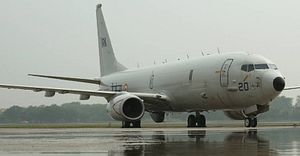The Indian government’s decision to purchase four additional Boeing P-8I aircraft through the U.S. Foreign Military Sales program addresses a gap in India’s airborne anti-submarine warfare capability. While the additional P-8Is will improve the capabilities of the Indian Navy, there is a corresponding need for acquiring force-multipliers and developing tactics to maximize the potential of such expensive platforms.
The current plan is for the four additional aircraft to arrive within the next three years, bringing India’s total number of P-8Is to 12. These maritime patrol aircraft have the ability to quickly search a wide area of water with sonobuoy patterns and guide other forces onto suspected “contacts” (submarines). The additional capability can be crucial, as surface warships and even submarines can find it very difficult to reliably find, shadow, and maintain contact with modern rival submarines in large ocean expanses.
The Indian Navy is presently struggling to acquire sufficient anti-submarine (ASW) forces in its surface or attack submarine fleet to adequately ensure in the future the safety of its Arihant-class ballistic missile submarines (SSBNs) and aircraft carriers. The government’s current wider commitments in the region also require maintain assets on stations at the Andaman and Nicobar islands and in the Indian Ocean Region. Enhancing the operational effectiveness and flexibility of limited aerial anti-submarine assets requires the adoption of evolved doctrines and specific operating concepts that enable in-tandem operations involving manned and unmanned assets.
The P-8 in U.S. service has been designed to interoperate with the Northrop Grumman’s MQ-4C Triton – a maritime wide-area surveillance version of the successful MQ-4 Global Hawk UAV, which covers vast portions of the sea for long periods of time. The MQ-4C Triton covers broad area maritime surveillance (BAMS), allowing P-8s to focus on ASW and anti-surface warfare. While the expensive Triton is unlikely to be procured for operations alongside India’s P-8I fleet, it highlights the need for the navy to explore the future adoption of autonomous unmanned aerial vehicles for adjunct missions, allowing the use of manned aircraft more efficiently.
Meanwhile, there is a plan for India to acquire ship-borne unmanned aerial vehicles (UAVs). The adoption of ship-borne UAVs can incrementally complement maritime patrol aircraft like the P-8 Is and ASW helicopters at sea in intelligence, surveillance, and reconnaissance (ISR), helping boost battle space awareness and target acquisition. The navy has a stated requirement of 50 such UAVs, which is currently stuck in the tendering stage. The navy has previously experimented — unsuccessfully — with the Chetak/Alouette-III helicopter in collaboration with Hindustan Aeronautics and Israeli Aerospace Industries. Combining UAVs and ASW helicopters on shipborne air detachments will provide Indian warships a high degree of tactical flexibility in high-threat environments, reducing risk to crews, as well as making targeting faster and more precise.
However, it is the P-8I’s coordination with submarines that holds the greatest promise.
Submarines are one of the fastest growing areas of military modernization in the Indo-Pacific. In the past few years, India, Vietnam, Indonesia, and Australia have all moved to acquire modern submarine forces. Needless to say, it is China’s growing submarine fleet that has been the trigger for India’s own initiatives to bolster its undersea forces. By 2020, China is likely to have a fleet of more than 70 submarines. The focus on China’s rapidly growing underwater warfare capability is central to understanding the importance of anti-submarine warfare for the Indian Navy.
Compounding Indian concerns over China’s increasing underwater ambition in the Indian Ocean, Pakistan is in the process of purchasing 8 Type 039A/Type 041 Yuan-class diesel-electric submarines from Beijing. Added to the existing three French Agosta-90B/Khalid and two Agosta-70 submarines of the Pakistan Navy, the Indian Navy faces a significant underwater threat in the years to come. The most effective method of locating and coordinating attacks on those submarines is an maritime patrol aircraft capability, in the form of the P-8I coupled with ship-borne ASW helicopters, which exponentially increases the ability of a warship to triangulate and prosecute an underwater target.
Extending the P-8I’s range and endurance on station during long maritime surveillance and anti-submarine patrols will require access to air-to-air refueling. Currently, the Indian Air Force’s Ilyushin IL-78 air-to-air refueling tanker aircraft cannot refuel the P-8I, as they are equipped with only a probe and drogue refueling system. Since the P-8Is will form a significant part of Indian airpower, any future acquisition of refueling aircraft will have to be configured to include an aerial refueling boom system compatible with the aircraft.
The P-8Is in Indian service are equipped with AGM-84L Harpoon Block II anti-ship missiles, Mk 54 lightweight torpedoes, and Mk-82 depth charges. The platform holds potential to include high-altitude ASW weapons like the Mk54 torpedo with a Boeing-built wing kit and net-enabled weapons like AGM-154 Joint Standoff Weapon (JSOW) and very likely the upcoming Long Range Anti-Ship Missile or LRASM, which are being adopted by the U.S. Navy for its P-8As. Exploring the inclusion of similar weapons systems would allow Indian aircraft to maintain a wide search area and increased standoff ranges from threats.
With the adoption of relevant operational concepts, Indian naval air assets can increase their endurance and range in tracking and deterring PLAN submarine forays into the region. The Logistics Exchange Memorandum of Agreement, when signed with the United States, holds the potential to enable and extend these operations deep into the Indian Ocean. While mutual consent is a tenet of the agreement, Indian access to certain U.S. military bases — like Diego Garcia, Djibouti, and Bahrain — to extend ASW operations is mutually reinforcing and worth exploring.
The P-8I expands an extremely potent ASW capability for the Indian Navy. Alongside the wider maritime patrol mission set that includes secondary tasks such as search-and-rescue and surveillance, the aircraft will fill a serious gap in the navy’s ASW capabilities as it confronts Chinese submarines increasingly capable of long range operations in the Indian Ocean.
Pushan Das is a Junior Fellow at the Observer Research Foundation in New Delhi.

































